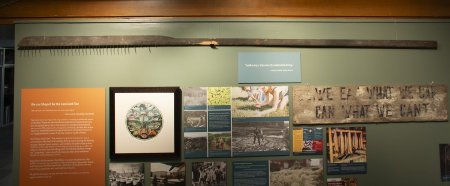Herring Rake
The herring spawn signals the arrival of spring, a cause for celebration as Southeast Alaska emerges from the cold, wet, and dark days of winter. Herring start to spawn in their third or fourth year, and become more productive as they age. During the spawn, pockets of offshore waters become turquoise as the white milt the males deposit mixes with eggs from the females. An average adult female can produce as many as 20,000 eggs with each release. The sticky, translucent eggs accumulate on almost anything near the shore, from rocks on the beach to seaweed. To increase the harvest, Native peoples traditionally put branches of hemlock, prized for its soft needles, into the water to catch eggs.
This month's featured artifact is a herring rake, resembling a long oar and made out of Douglas fir with brass tines for spearing fish. It was found at the home of a fisherman on Pennock Island. Gilbert McLeod, a white man born in 1904 in the Haida village of Howkan on Prince of Wales Island, vividly recalled herring harvests from his youth where herring rakes similar to this one were used. "The oldtimers always carried a herring rake in their rowboats... He'd stand paddling in the front of the boat, holding the herring rake with the sharp points in. In a school or a ball of herring, he'd turn the sharp ends toward the herring, pierce them and bring the rake up to the boat with them, squirming, impaled on the tines," McLeod shared in the 1960s.
Herring populations around Ketchikan have fluctuated for more than a century, at times being abundant enough for waters like the Tongass Narrows to look like they are "boiling" with activity and other times at near collapse. Overfishing, migrating populations, an increasing number of predators, and the effects of climate change present challenges to the current health of the fishery. Through commercial harvest, the Ketchikan Indian Community (KIC) sustainably processes herring eggs for an annual distribution to local Native families. In 2023, KIC gave out 291 bags of herring eggs on hemlock branches and 193 bags of herring eggs on kelp.
Object ID #: 2023.2.16.1


